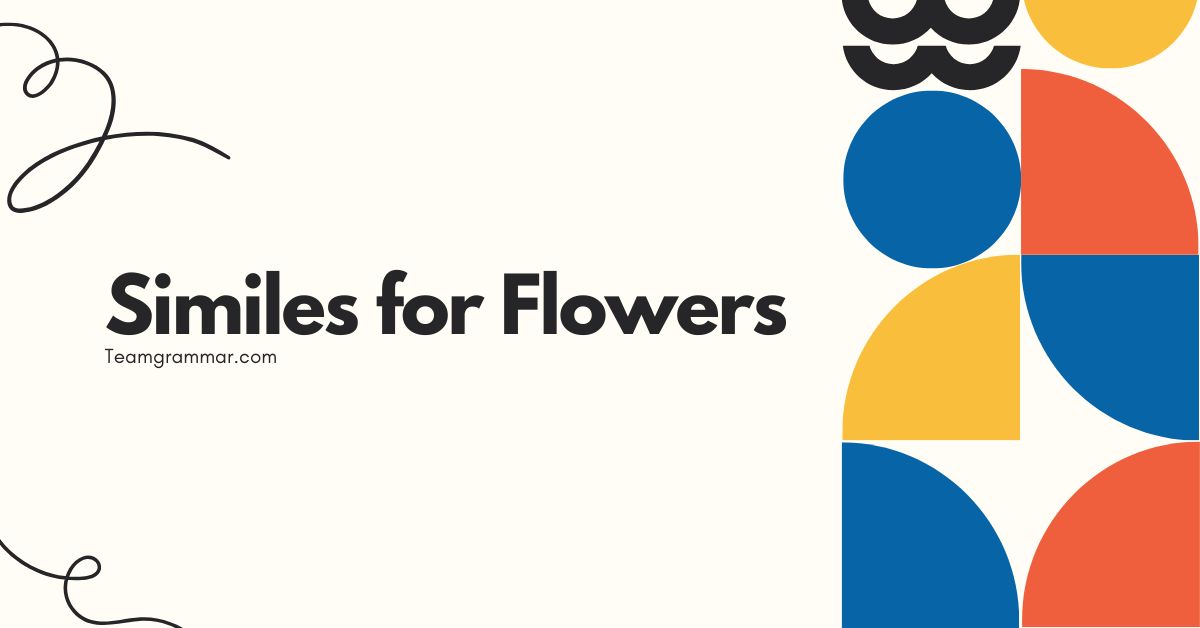41 Similes for Flowers: Enhancing Descriptions with Figurative Language
Understanding similes is crucial for enriching your descriptive writing and enhancing your comprehension of figurative language. Similes, a cornerstone of literary and everyday expression, allow us to draw vivid comparisons, making our descriptions more engaging and memorable.
This article delves into the world of similes specifically related to flowers, providing you with the knowledge and tools to use them effectively. Whether you’re a student, writer, or language enthusiast, this guide will help you master the art of creating and interpreting similes that evoke the beauty and essence of flowers.
Table of Contents
- Introduction
- Definition of Simile
- Structural Breakdown of Similes
- Types of Similes
- Examples of Similes for Flowers
- Usage Rules for Similes
- Common Mistakes with Similes
- Practice Exercises
- Advanced Topics in Similes
- Frequently Asked Questions
- Conclusion
Introduction
Similes are powerful tools in the English language, allowing us to paint vivid pictures with words. By comparing one thing to another, we can evoke emotions, create imagery, and add depth to our writing.
This article focuses specifically on similes used to describe flowers, exploring how these comparisons can enhance our appreciation and understanding of floral beauty. By the end of this guide, you’ll be equipped to use similes effectively to describe flowers in a way that is both creative and accurate.
Whether you are a student learning the basics of figurative language, a writer seeking to add flair to your prose, or simply someone who appreciates the beauty of flowers, this article offers valuable insights and practical examples. We will cover the definition of similes, their structure, different types, usage rules, common mistakes, and even provide practice exercises to solidify your understanding.
Let’s embark on this journey to explore the world of similes for flowers, transforming ordinary descriptions into extraordinary expressions.
Definition of Simile
A simile is a figure of speech that compares two unlike things using the words “like” or “as.” The primary function of a simile is to create a vivid image or to emphasize a particular quality by drawing a comparison to something familiar. Similes are widely used in literature, poetry, and everyday conversation to make descriptions more engaging and relatable.
Unlike metaphors, which directly equate two things (e.g., “He is a lion”), similes acknowledge the difference between the two things being compared while highlighting a shared characteristic. This distinction is crucial for understanding the nuances of figurative language.
The effectiveness of a simile lies in its ability to evoke a clear and impactful image in the reader’s mind, making the description more memorable and meaningful.
Classification of Similes
Similes can be classified based on the type of comparison they make. Some similes focus on physical appearance, while others highlight behavior, emotion, or abstract qualities.
Understanding these classifications can help you choose the most appropriate simile for your specific purpose.
- Descriptive Similes: These focus on physical attributes, such as color, shape, or texture. Example: “The rose was as red as blood.”
- Behavioral Similes: These compare behaviors or actions. Example: “The sunflowers stood as tall as soldiers.”
- Emotional Similes: These relate to feelings or emotions. Example: “Her smile was as bright as a daisy.”
- Abstract Similes: These compare abstract qualities or concepts. Example: “Their love was like a blossoming garden.”
Function of Similes
The primary function of a simile is to enhance description and create a more vivid image in the reader’s mind. By drawing a comparison between two unlike things, similes can make abstract concepts more concrete and relatable.
They also add emotional depth and can evoke a specific mood or feeling. Similes are essential for effective communication and creative expression.
Furthermore, similes can be used to simplify complex ideas by relating them to something familiar. This makes it easier for the audience to understand and connect with the message.
In persuasive writing, similes can be used to sway opinions by associating a subject with something positive or negative. Overall, similes are versatile tools that can enhance communication in a variety of contexts.
Contexts of Simile Usage
Similes are used in a wide range of contexts, from literature and poetry to everyday conversation and advertising. In literature, similes are used to create vivid imagery and add depth to character descriptions and plot development.
In poetry, they contribute to the rhythm and flow of the verse, enhancing the emotional impact of the poem. In everyday conversation, similes make descriptions more engaging and relatable.
In advertising, similes are used to associate products with positive qualities or desirable outcomes. For example, a skincare product might be described as making your skin “as smooth as a petal.” In scientific writing, similes can be used to explain complex concepts in a more accessible way.
Understanding the various contexts in which similes are used can help you appreciate their versatility and effectiveness as a communication tool.
Structural Breakdown of Similes
The basic structure of a simile includes three key elements: the subject being described, the word “like” or “as,” and the object or concept to which the subject is being compared. Understanding these elements is crucial for constructing effective and meaningful similes.
The subject is the noun or pronoun that is being described. The word “like” or “as” acts as the connecting link between the subject and the object of comparison.
The object of comparison is the noun or concept that is used to highlight a particular quality or characteristic of the subject. The combination of these elements creates a simile that is both descriptive and engaging.
Identifying the Subject
The subject of a simile is the entity being described. It is the focus of the comparison and the element that the simile aims to illuminate.
In the context of flowers, the subject could be a specific type of flower, a bouquet, or even a characteristic of a flower, such as its color or scent.
For example, in the simile “The rose is like a velvet curtain,” the subject is “the rose.” Identifying the subject is the first step in understanding the meaning and purpose of the simile. It helps to clarify what aspect of the subject is being emphasized through the comparison.
The Role of “Like” or “As”
The words “like” and “as” are the essential connectors in a simile. They indicate that a comparison is being made between two unlike things.
While both words serve the same purpose, there are subtle differences in their usage. “Like” is often used in more informal contexts, while “as” can be used in both formal and informal settings.
The choice between “like” and “as” can also depend on the specific phrasing of the simile. For example, “as” is often used in conjunction with adjectives, such as “as beautiful as a sunset.” Understanding the nuances of these words can help you construct similes that are both grammatically correct and stylistically effective.
The Object of Comparison
The object of comparison is the entity to which the subject is being compared. It is chosen to highlight a particular quality or characteristic of the subject.
The effectiveness of a simile depends on the relevance and clarity of this comparison. The object of comparison should be something that is familiar and easily understood by the audience.
For example, in the simile “The sunflower is as bright as the sun,” the object of comparison is “the sun.” This comparison highlights the sunflower’s vibrant color and its tendency to face the sun. The object of comparison should be carefully selected to create a vivid and meaningful image in the reader’s mind.
Types of Similes
Similes can be categorized based on the type of comparison they make. Understanding these categories can help you choose the most effective simile for your specific descriptive needs.
Common types include descriptive, emotional, behavioral, and abstract similes.
Each type of simile serves a different purpose and evokes a different response from the reader. By mastering the different types of similes, you can enhance your writing and create more impactful descriptions.
Let’s explore each type in more detail.
Descriptive Similes
Descriptive similes focus on physical characteristics, such as color, shape, size, or texture. These similes aim to create a visual image in the reader’s mind by comparing the subject to something that shares similar physical attributes.
They are particularly useful for describing the appearance of flowers.
Examples of descriptive similes for flowers include: “The petals were as soft as silk,” “The flower was as red as a ruby,” and “The stem was as slender as a reed.” These similes use familiar objects to highlight specific physical qualities of the flower, making the description more vivid and memorable.
Emotional Similes
Emotional similes compare the emotions or feelings associated with the subject to other emotions or experiences. These similes are used to evoke a particular mood or feeling in the reader.
They can add depth and emotional resonance to your descriptions of flowers.
Examples of emotional similes for flowers include: “Her joy bloomed like a flower in spring,” “His love for her was as tender as a rose,” and “The memory of her was as sweet as the scent of jasmine.” These similes connect the beauty and fragrance of flowers to human emotions, creating a powerful and evocative image.
Behavioral Similes
Behavioral similes compare the actions or behaviors of the subject to other actions or behaviors. These similes are used to describe how the subject moves, grows, or interacts with its environment.
They can add a sense of dynamism and life to your descriptions of flowers.
Examples of behavioral similes for flowers include: “The flower swayed in the breeze like a dancer,” “The vine climbed the trellis like a determined explorer,” and “The petals unfolded like a secret being revealed.” These similes use action words to bring the flowers to life and highlight their unique characteristics.
Abstract Similes
Abstract similes compare abstract qualities or concepts to other abstract ideas. These similes are used to convey deeper meanings and symbolic associations.
They can add layers of complexity and interpretation to your descriptions of flowers.
Examples of abstract similes for flowers include: “Their friendship blossomed like a garden,” “Hope sprang eternal, like a wildflower in the desert,” and “Life is as fragile as a flower petal.” These similes use flowers as metaphors for abstract concepts, creating a powerful and thought-provoking image.
Examples of Similes for Flowers
This section provides a variety of examples of similes used to describe flowers, categorized by the type of comparison they make. These examples will help you understand how to use similes effectively to enhance your descriptive writing.
The following tables provide extensive examples of similes for flowers, categorized by descriptive, emotional, behavioral, and abstract comparisons. Each table includes at least 20 examples to illustrate the diversity and creativity of simile usage.
Descriptive Similes Examples
The following table provides examples of descriptive similes for flowers, focusing on physical characteristics such as color, shape, size, and texture.
| Simile | Explanation |
|---|---|
| The rose was as red as blood. | Compares the rose’s color to the intense red of blood. |
| The petals were as soft as silk. | Compares the texture of the petals to the smoothness of silk. |
| The sunflower was as tall as a child. | Compares the height of the sunflower to a child’s height. |
| The daisy was as white as snow. | Compares the daisy’s color to the pure white of snow. |
| The tulip was shaped like a cup. | Compares the tulip’s form to the shape of a cup. |
| The lavender was as fragrant as perfume. | Compares the scent of lavender to the aroma of perfume. |
| The orchid was as delicate as glass. | Compares the orchid’s fragility to the breakability of glass. |
| The blossom was as pink as bubblegum. | Compares the blossom’s color to the bright pink of bubblegum. |
| The poppy was as vibrant as a sunset. | Compares the poppy’s color to the vivid colors of a sunset. |
| The lily was as pure as moonlight. | Compares the lily’s color to the serene purity of moonlight. |
| The carnation was as ruffled as a flamenco dancer’s skirt. | Compares the carnation’s petals to the ruffled skirt. |
| The hyacinth was as blue as the summer sky. | Compares the hyacinth’s color to the blue of the sky. |
| The marigold was as orange as a pumpkin. | Compares the marigold’s color to the orange of a pumpkin. |
| The violet was as purple as an amethyst. | Compares the violet’s color to the purple of an amethyst. |
| The dahlia was as intricate as a snowflake. | Compares the dahlia’s intricate petals to the complexity of a snowflake. |
| The chamomile was as calming as a warm bath. | Compares the chamomile’s effect to the relaxation of a bath. |
| The gerbera daisy was as cheerful as a sunny day. | Compares the gerbera daisy’s appearance to the happiness of a sunny day. |
| The chrysanthemum was as complex as a maze. | Compares the chrysanthemum’s many petals to the complexity of a maze. |
| The freesias were as colorful as a rainbow. | Compares the freesias’ variety of colors to the colors of a rainbow. |
| The petunias were as velvety as a curtain. | Compares the petunias’ texture to the softness of velvet. |
| The gladiolus stood as erect as a soldier. | Compares the gladiolus’ upright posture to a soldier’s stance. |
| The zinnia was as bright as a crayon. | Compares the zinnia’s color to the vibrancy of a crayon. |
| The aster was as star-like as a constellation. | Compares the aster’s shape to the shape of a star. |
Emotional Similes Examples
The following table provides examples of emotional similes for flowers, focusing on the feelings and emotions associated with them.
| Simile | Explanation |
|---|---|
| Her joy bloomed like a flower in spring. | Compares her happiness to the blossoming of flowers in spring. |
| His love for her was as tender as a rose. | Compares his affection to the gentleness of a rose. |
| The memory of her was as sweet as the scent of jasmine. | Compares the pleasant memory to the fragrance of jasmine. |
| Her sadness wilted like a flower in winter. | Compares her sorrow to the fading of flowers in winter. |
| Their friendship blossomed like a garden. | Compares their relationship to the growth of a garden. |
| Hope sprang eternal, like a wildflower in the desert. | Compares hope to the resilience of a wildflower. |
| Her laughter was as bright as a field of sunflowers. | Compares her cheerful laughter to a sunny field of sunflowers. |
| His gratitude was as deep as the roots of a tree. | Compares his thankfulness to the deep roots of a tree. |
| Their bond was as strong as the stem of an oak. | Compares their strong connection to the sturdy stem of an oak. |
| Her resilience was as unwavering as a mountain. | Compares her strength to the steadfastness of a mountain. |
| His words were as soothing as lavender. | Compares his comforting words to the calming scent of lavender. |
| Her spirit was as free as a dandelion in the wind. | Compares her independence to the unburdened nature of a dandelion. |
| Their patience grew like a slow-blooming flower. | Compares their growing patience to a flower that blooms slowly. |
| Her kindness spread like seeds in the wind. | Compares her generosity to the scattering of seeds. |
| His passion burned as bright as a flame. | Compares his strong enthusiasm to a bright flame. |
| Their forgiveness flowed as freely as a river. | Compares their willingness to forgive to the unrestrained nature of a river. |
| Her courage stood tall like a sunflower. | Compares her bravery to the height of a sunflower. |
| His wisdom grew like the rings of a tree. | Compares his increasing knowledge to the growth rings of a tree. |
| Their memories lingered like the scent of roses. | Compares their enduring memories to the persistent fragrance of roses. |
| Her dreams bloomed like morning glories. | Compares her aspirations to the blossoming of morning glories. |
| His determination was as firm as a tree trunk. | Compares his strong resolve to the unyielding nature of a tree trunk. |
| Her heart was as open as a field of daisies. | Compares her receptive nature to the openness of a field of daisies. |
| Their understanding deepened like roots intertwining. | Compares their growing comprehension to the intertwining of roots. |
Behavioral Similes Examples
The following table provides examples of behavioral similes for flowers, focusing on their actions and movements.
| Simile | Explanation |
|---|---|
| The flower swayed in the breeze like a dancer. | Compares the flower’s gentle movement to a dancer’s swaying. |
| The vine climbed the trellis like a determined explorer. | Compares the vine’s upward growth to an explorer’s determination. |
| The petals unfolded like a secret being revealed. | Compares the petals opening to the unveiling of a secret. |
| The leaves rustled in the wind like whispers. | Compares the sound of the leaves to quiet whispers. |
| The flowers turned their faces to the sun like worshippers. | Compares the flowers’ movement to the sun to the devotion of worshippers. |
| The buds swelled like balloons ready to burst. | Compares the buds’ growth to balloons expanding. |
| The seeds scattered in the wind like confetti. | Compares the seeds spreading to the scattering of confetti. |
| The roots burrowed into the earth like determined miners. | Compares the roots digging to the determination of miners. |
| The branches reached for the sky like grasping hands. | Compares the branches’ upward growth to reaching hands. |
| The petals closed at night like sleepy eyes. | Compares the petals closing to closing eyes at night. |
| The flowers drank in the rain like thirsty travelers. | Compares the flowers absorbing water to travelers drinking. |
| The stems bent in the storm like resilient dancers. | Compares the stems swaying to the resilience of dancers. |
| The blossoms bloomed overnight like a sudden surprise. | Compares the blossoms opening to a sudden surprise. |
| The leaves fluttered in the wind like nervous butterflies. | Compares the leaves moving to the fluttering of butterflies. |
| The seeds sprouted like tiny miracles. | Compares the seeds growing to tiny miracles happening. |
| The branches swayed like arms in the breeze. | Compares the branches moving to arms swaying. |
| The petals danced in the sunlight like joyful spirits. | Compares the petals moving to the joy of spirits. |
| The roots gripped the soil like anchors. | Compares the roots holding to anchors securing. |
| The blossoms faded like memories slipping away. | Compares the blossoms wilting to fading memories. |
| The flowers stretched towards the light like eager students. | Compares the flowers growing to the eagerness of students. |
| The leaves glistened like jewels after the rain. | Compares the leaves shining to the sparkle of jewels. |
| The stems twisted like dancers in an embrace. | Compares the stems intertwining to dancers embracing. |
| The flowers nodded in the breeze like old friends greeting each other. | Compares the flowers swaying to friends greeting. |
Abstract Similes Examples
The following table provides examples of abstract similes for flowers, focusing on deeper meanings and symbolic associations.
| Simile | Explanation |
|---|---|
| Life is as fragile as a flower petal. | Compares the delicateness of life to a flower petal. |
| Their love blossomed like a garden in spring. | Compares their love to the flourishing of a garden. |
| Friendship is like a bouquet of different flowers. | Compares friendship to the variety of flowers in a bouquet. |
| Memories are like pressed flowers in a book. | Compares memories to preserved flowers in a book. |
| Inspiration is like a seed that needs nurturing. | Compares inspiration to a seed needing care to grow. |
| Hope is as resilient as a wildflower. | Compares hope to the strength of a wildflower. |
| Dreams are as colorful as a field of tulips. | Compares dreams to the vibrant colors of tulips. |
| Time is like a flowing river carrying petals away. | Compares time to a river carrying petals away. |
| Peace is as calming as a field of lavender. | Compares peace to the soothing effect of lavender. |
| Patience is like watering a plant every day. | Compares patience to the consistent care of a plant. |
| Resilience is like a flower bending but not breaking. | Compares resilience to a flower surviving a storm. |
| Change is like the seasons in a garden. | Compares change to the natural cycles of a garden. |
| Growth is like a plant reaching for the sun. | Compares growth to a plant growing towards the sun. |
| Wisdom is like a tree with deep roots. | Compares wisdom to the stability of a tree’s roots. |
| Beauty is as fleeting as a blooming flower. | Compares beauty to the short-lived bloom of a flower. |
| Creativity is like planting seeds of new ideas. | Compares creativity to the act of planting new seeds. |
| Success is like harvesting a field of flowers. | Compares success to the rewarding harvest of flowers. |
| Kindness is like spreading seeds of love. | Compares kindness to the act of spreading love. |
| Forgiveness is like pruning dead branches. | Compares forgiveness to the removal of dead branches. |
| Understanding is like seeing a flower from every angle. | Compares understanding to fully appreciating a flower. |
| Innocence is as pure as a white lily. | Compares innocence to the purity of a lily. |
| Grief is like a garden overgrown with weeds. | Compares grief to an unkempt garden. |
| Hope is like a tiny sprout pushing through the soil. | Compares hope to a new plant emerging. |
Usage Rules for Similes
To use similes effectively, it is important to follow certain rules of grammar and style. These rules ensure that your similes are clear, meaningful, and grammatically correct.
Pay attention to subject-verb agreement, appropriate word choice, and logical comparisons.
Adhering to these usage rules will help you create similes that enhance your writing and convey your intended meaning effectively. Let’s explore these rules in more detail.
Subject-Verb Agreement
When constructing a simile, ensure that the subject and verb agree in number. This means that if the subject is singular, the verb must also be singular, and if the subject is plural, the verb must be plural.
This rule applies to both the subject of the main sentence and the subject of the comparative clause.
For example: “The flowerisas beautiful as a sunset” (singular subject and verb). “The flowersareas colorful as a rainbow” (plural subject and verb).
Maintaining subject-verb agreement ensures that your similes are grammatically correct and easy to understand.
Appropriate Word Choice
Choosing the right words is crucial for creating effective similes. The words “like” and “as” should be used correctly to indicate the comparison.
The object of comparison should be something that is familiar and easily understood by the audience. Avoid using clichés or overused comparisons that can diminish the impact of your simile.
For example, instead of saying “The flower was as beautiful as a flower,” which is redundant, try “The flower was as beautiful as a rare orchid.” The latter simile uses a more specific and evocative object of comparison, making the description more engaging.
Logical Comparisons
Ensure that the comparison made in your simile is logical and meaningful. The two things being compared should share a common characteristic that is relevant to the description.
Avoid making comparisons that are nonsensical or confusing.
For example, “The flower was as heavy as an elephant” is not a logical comparison because flowers are typically light and delicate, while elephants are known for their weight. A more logical simile would be “The flower was as delicate as a butterfly’s wing,” which highlights the shared characteristic of fragility.
Common Mistakes with Similes
Even experienced writers can make mistakes when using similes. Common errors include using clichés, creating illogical comparisons, and confusing similes with metaphors.
Being aware of these mistakes can help you avoid them in your own writing.
This section will address these common mistakes and provide examples of correct and incorrect usage. By understanding these pitfalls, you can improve your simile construction and enhance the quality of your writing.
Using Cliches
Cliches are overused expressions that have lost their impact due to overuse. Using clichéd similes can make your writing sound unoriginal and uninspired.
Avoid common similes such as “as red as a rose” or “as white as snow,” which have been used countless times.
Instead, strive to create fresh and original similes that are tailored to your specific subject and context. For example, instead of “as red as a rose,” try “as red as a newly opened pomegranate.” This simile is more specific and evocative, making your writing more engaging.
Illogical Comparisons
An illogical comparison occurs when the two things being compared do not share a relevant characteristic. This can result in a simile that is confusing or nonsensical.
Ensure that your similes are based on a clear and logical connection between the subject and the object of comparison.
For example, “The flower was as loud as a trumpet” is an illogical comparison because flowers do not typically produce sound. A more logical simile would be “The flower was as vibrant as a trumpet’s fanfare,” which highlights the shared characteristic of vibrancy and attention-grabbing quality.
Confusing Similes with Metaphors
Similes and metaphors are both figures of speech that make comparisons, but they do so in different ways. A simile uses the words “like” or “as” to make a comparison, while a metaphor directly equates two things without using these words.
Confusing these two figures of speech can lead to grammatical errors and unclear writing.
For example, a simile would be “The flower is like a jewel,” while a metaphor would be “The flower is a jewel.” The simile acknowledges that the flower is similar to a jewel, while the metaphor implies that the flower is a jewel. Understanding this distinction is crucial for using similes and metaphors correctly.
Practice Exercises
To solidify your understanding of similes for flowers, complete the following practice exercises. These exercises will test your ability to identify, construct, and use similes effectively.
Answer keys are provided at the end of the section.
These exercises include multiple-choice questions, fill-in-the-blank questions, and simile construction prompts. By completing these exercises, you will reinforce your knowledge of similes and improve your ability to use them in your own writing.
Exercise 1: Identify the Simile
Identify the simile in each of the following sentences.
| Question | Answer |
|---|---|
| 1. The flower was as delicate as a butterfly’s wing. | as delicate as a butterfly’s wing |
| 2. Her smile was a ray of sunshine. | (No simile – this is a metaphor) |
| 3. The petals were like velvet to the touch. | like velvet to the touch |
| 4. He is a strong oak tree. | (No simile – this is a metaphor) |
| 5. The flower swayed in the breeze like a dancer. | like a dancer |
| 6. The scent of the jasmine was intoxicating. | (No simile) |
| 7. The garden was as colorful as a rainbow. | as colorful as a rainbow |
| 8. Time is a thief. | (No simile – this is a metaphor) |
| 9. The flowers stood as tall as soldiers. | as tall as soldiers |
| 10. His heart was a garden. | (No simile – this is a metaphor) |
Exercise 2: Fill in the Blanks
Complete the following similes by filling in the blanks with appropriate words.
| Question | Answer |
|---|---|
| 1. The flower was as _______ as snow. | white |
| 2. Her love was like a _______ garden. | blooming |
| 3. The petals felt as soft as _______. | silk |
| 4. The sunflower stood as _______ as a soldier. | tall |
| 5. His words were as sweet as _______. | honey |
| 6. The leaves rustled like _______. | whispers |
| 7. The flower’s scent was as strong as _______. | perfume |
| 8. The thorns were as sharp as _______. | needles | sunshine |
| 10. The branches reached like _______ hands. | grasping |
Exercise 3: Simile Construction
Create a simile for each of the following prompts, using the words “like” or “as.”
| Prompt | Example Answer |
|---|---|
| 1. Describe the color of a poppy. | The poppy was as red as a drop of blood. |
| 2. Describe the texture of a rose petal. | The rose petal felt like smooth velvet. |
| 3. Describe the scent of lavender. | The lavender smelled as calming as a peaceful meadow. |
| 4. Describe how a sunflower moves in the wind. | The sunflower swayed in the wind like a graceful dancer. |
| 5. Describe the feeling of hope. | Hope is like a tiny seed sprouting in the dark. |
Advanced Topics in Similes
Beyond the basics, there are advanced techniques and considerations that can further enhance your use of similes. These include exploring extended similes, understanding the cultural context of similes, and using similes to create nuanced meanings.
This section delves into these advanced topics, providing you with the knowledge and skills to use similes in more sophisticated and impactful ways. Let’s explore these advanced concepts in more detail.
Extended Similes
An extended simile is a simile that is developed over several lines or sentences. Instead of making a brief comparison, an extended simile explores the similarities between the subject and the object of comparison in greater detail.
This technique can create a more vivid and impactful image in the reader’s mind.
For example: “The garden was like a symphony orchestra, with each flower playing its part. The roses were the violins, their sweet fragrance weaving a melody of love.
The lilies were the trumpets, their bright white petals announcing joy and celebration. The daisies were the flutes, their delicate presence adding a touch of whimsy and charm.” This extended simile uses multiple sentences to develop the comparison between the garden and a symphony orchestra, creating a rich and immersive experience for the reader.
Cultural Context of Similes
The meaning and impact of a simile can be influenced by cultural context. Similes that are effective in one culture may not be as meaningful or relevant in another.
Understanding the cultural associations and connotations of the objects of comparison is crucial for using similes appropriately and effectively.
For example, the simile “as white as snow” may evoke feelings of purity and innocence in Western cultures, but in cultures where snow is rare or associated with hardship, it may have a different connotation. Being aware of these cultural nuances can help you create similes that are culturally sensitive and resonant.
Creating Nuanced Meanings
Similes can be used to create nuanced meanings by carefully selecting the object of comparison and considering its various connotations. The choice of words and the way the simile is structured can subtly influence the reader’s interpretation of the subject.
For example, comparing a flower to a “delicate butterfly” emphasizes its fragility and beauty, while comparing it to a “resilient weed” highlights its strength and adaptability. By carefully considering the connotations of the object of comparison, you can create similes that convey complex and nuanced meanings.
Frequently Asked Questions
This section addresses some frequently asked questions about similes for flowers. These questions cover various aspects of simile usage, from basic definitions to more advanced techniques.
What is the difference between a simile and a metaphor?
A simile compares two things using “like” or “as,” while a metaphor directly equates two things without using these words. For example, “The flower is like a jewel” (simile) vs.
“The flower is a jewel” (metaphor).
How can I avoid using clichés in my similes?
Strive to create fresh and original comparisons that are tailored to your specific subject and context. Avoid overused expressions and seek more specific and evocative objects of comparison.
What makes a simile effective?
An effective simile is clear, logical, and meaningful. It uses appropriate word choice and creates a vivid image in the reader’s mind.
The object of comparison should be familiar and relevant to the subject.
Can a simile be too long?
Yes, a simile can be too long if it becomes repetitive or loses focus. An extended simile should be developed thoughtfully and purposefully, with each element of the comparison contributing to the overall meaning.
How do I choose the right object of comparison for my simile?
Consider the qualities or characteristics you want to emphasize about the subject. Choose an object of comparison that shares those qualities and is familiar to your audience.
Think about the connotations and associations of the object of comparison to ensure that it conveys the intended meaning.
Conclusion
Similes are powerful tools for enhancing descriptive writing and adding depth to your expression. By understanding the structure, types, and usage rules of similes, you can effectively use them to create vivid and meaningful comparisons.
Whether you are describing the beauty of a flower or conveying a complex emotion, similes can help you communicate your message in a more engaging and impactful way.
Remember to avoid common mistakes such as using clichés or creating illogical comparisons. Strive to create fresh and original similes that are tailored to your specific subject and context.
With practice and attention to detail, you can master the art of using similes and transform your writing into a more expressive and compelling form of communication. Embrace the beauty and versatility of similes, and let your words bloom like a garden in spring.







